

Also in 1940, Miguel de Oliveira published in the Revista de Guimarães [Guimarães Magazine] one of his most solid pieces of fundamental research, which, ten years later, was given its own version under the title As paróquias rurais portuguesas – Sua origem e formação [Portuguese rural parishes - Their origin and formation]. In this version he incorporated the critical suggestions of Torquato de Sousa Soares, who favourably assessed the work and invited him to collaborate with the Revista Portuguesa de História [Portuguese Magazine of History]. In this magazine he published Origens da Ordem de Cister em Portugal [Origins of the Cistercian Order in Portugal] and Santa Iria e Santarém [Saint Iria and Santarém].
From the second half of the 1950s, he continued to develop a historiographical activity characterised by the role he played in founding and directing the Centro de Estudos de História Eclesiástica (CEHE) [Centre for Studies in Ecclesiastical History], of which the current Centro de Estudos de História Religiosa [Centre for Studies in Religious History] is a successor. In response to the challenge made by the Comité International des Sciences Historiques [International Committee of Historical Sciences], which noted the absence of a Portuguese historiography at the International Congresses of Historical Sciences, Miguel de Oliveira led the Commission created during the founding meeting of the CEHE held on 5 January 1956, which included António da Silva Rego, António Brásio, and Avelino de Jesus da Costa. Together with Bernardo Xavier Coutinho and Mário Martins, they became part of the Editorial Board of CEHE magazine, which Miguel de Oliveira named Lusitania Sacra [Sacred Lusitania] (still being published today). He published some of his final works in this magazine, including Inquirições de D. Afonso III na Terra de Santa Maria [Enquiries of King Afonso III in the Land of Santa Maria] in the last issue. In the meantime, he had contributed with several articles to the German encyclopaedias Lexikon für Theologie und Kirche and Lexikon der Marienkunde . After being awarded the rank of Officer of the Military Order of Santiago da Espada in 1945, he was elected a corresponding member of the Academia Portuguesa da História [Portuguese Academy of History] in 1951 and became an academician in April 1956, succeeding Henrique de Campos Ferreira Lima in seat no. 16. He died in Lisbon on 15 February 1968. In his honour, the elementary school in his hometown was named after him in December 1998.
This work is financed by national funds through FCT - Foundation for Science and Technology, I.P, in the scope of the projects UIDB/04311/2020 and UIDP/04311/2020.
